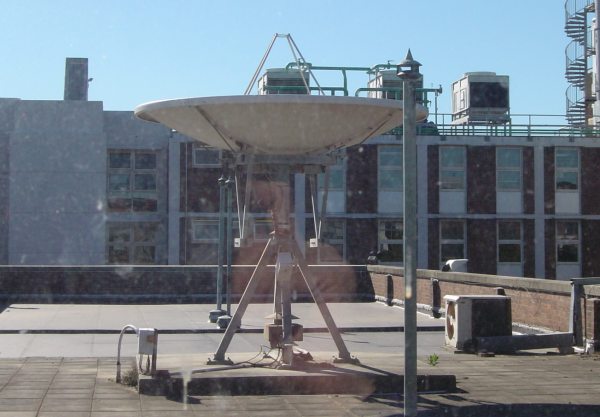

News31 March - Went up onto the roof to work on motors, etc. Bad news (as I suspected). The main elevation actuator has seized due to rust and azimuth bearings are almost as bad. These will be expensive to fix which more than likely means that they will not get fixed and we will not be able to do any observing 2004 news 5th July - presented draft operating report to John Story 2nd July - Meet with 3rd year lab manager to discuss project 11th June - Proposal submitted to John Story, project mentioned at School OH&S meeting.
|
OverviewThe School of Physics is allowing Physoc to start a student run radioastronomy project. The School has a satellite dish on the roof of the Old Main Building, which is steerable, has a variety of equipment for use with it located in a small room in Astrophysics on the 1st floor of the building. The Dish: 3.7M Acesat spun aluminium, f/D 0.375, Gain 51.5dBi @
12GHz, 400 degree azimuth, approx -5 to 95 elevation. Servo system is a
Omnitech Robotics MC1000 ISA card, connected to a in house built power
amp for motors, 900 count/turn encoders on actuators. In the past students have used the equipment for various projects (including honours), so there should be enough information to get us started. We invite physics students who are interested in learning in radio astronomy and radio physics to join the group. We also hope to use it to demonstrate the basics of radio astronomy to students who are attending the annual Astrotrip, as the trip visits at least one radio telescope (this year we visit 2 facilities). You do not need any experience in radioastronomy or astrophysics (hopefully you learn some in the lectures). Hopefully the project will continue indefinitely, kept alive by new students joining the group and older students passing on their knowledge to the new people. |
|
|
Initial Project Plan/Goals
If the bearings does become a "too hard" problem there are alternatives such as Meteor counting and noise from Jupiter, which are within the limits of the equipment (around 30-40MHz) . All they require is us to build a basic dipole antenna with some long lengths of wire. http://www.atnf.csiro.au/people/rsault/jupiter/ http://www.radiosky.com/ |
|
Primary contact and page author: David Kruss, dkruss@phys.unsw.edu.au DocumentsOur own documents Draft Operating Procedure (Word 2000 format) Here are some documents that have been written within the school. A Radiotelescope for Undergrad teaching
|
| Links that discuss basic
radio astronomy I have found
http://www.phys.unsw.edu.au/astro/resources/astro_dome.html http://web.haystack.mit.edu/SRT/index.html http://www.atnf.csiro.au/projects/mnrf/inter_summary.html http://www.bambi.net/sara/cliff.htm http://www.radioastro.net http://www.asnsw.com/wiruna/rt.htm http://www.radiosky.com/ http://www.users.bigpond.com/tmccarth/ http://www.atnf.csiro.au |
|
Member List (area of expertise) Ankur Chaudhary Justin Dinale David Kruss Vamsi Gullapalli Chris Nugroho Andrew Sunderland Ilona Coote Rosebud Lambert Tony Whelan Emma Rainforth Reuben Webster Chris Nickel |
Dave's Unofficial CommentsFrom various discussions I have had I have come to the opinion that OH&S could be very prohibitive in this project. The location of the dish itself alone generates many safety issues with several departments and the fact that we are undergraduates doesn't help the situation. The climate we have come to live in is the largely the result of knee jerk reactions by narrow minded lawmakers and people who do not take responsibility for their actions. I accept that there is a need for safety and that there have been genuine cases where mistakes have been made. As an example of how petty things have become one only needs to read this document SOP - Computer Use. I hope that in my lifetime society will have progressed to have some common sense rather that blame someone mentality. |
Another view

17/07/2004
© Physoc 2004